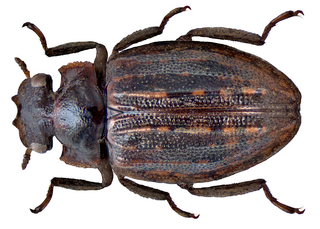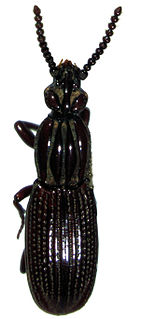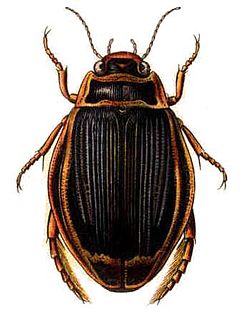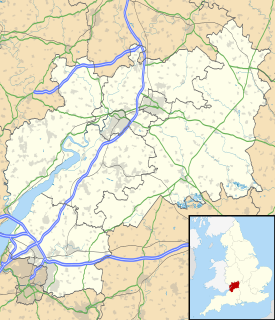
Spercheus is a genus of aquatic beetles which are placed in a family of their own, Spercheidae. About 20 species are known from around the world, with the majority being from the Oriental and Afrotropical Realms.

Ground beetles are a large, cosmopolitan family of beetles, the Carabidae, with more than 40,000 species worldwide, around 2,000 of which are found in North America and 2,700 in Europe. As of 2015, it is one of the 10 most species-rich animal families.

Rhysodidae is a family of beetles, consisting of more than 350 species in about 20 genera.

The rove beetles are a family (Staphylinidae) of beetles, primarily distinguished by their short elytra that typically leave more than half of their abdominal segments exposed. With roughly 63,000 species in thousands of genera, the group is currently recognized as the largest extant family of organisms. It is an ancient group, with fossilized rove beetles known from the Triassic, 200 million years ago, and possibly even earlier if the genus Leehermania proves to be a member of this family. They are an ecologically and morphologically diverse group of beetles, and commonly encountered in terrestrial ecosystems.

The Adephaga, with more than 40,000 recorded species in 10 families, are a suborder of highly specialized beetles and the second-largest suborder of the order Coleoptera. Members of this suborder are collectively known as adephagans, and include ground beetles and a variety of aquatic beetles, such as predaceous diving beetles and whirligig beetles. Most of the species belong to the family Carabidae.

The Anthicidae are a family of beetles that resemble ants. They are sometimes called ant-like flower beetles or ant-like beetles. The family comprises over 3,500 species in about 100 genera.

Histeridae is a family of beetles commonly known as clown beetles or Hister beetles. This very diverse group of beetles contains 3,900 species found worldwide. They can be easily identified by their shortened elytra that leaves two of the seven tergites exposed, and their geniculate (elbowed) antennae with clubbed ends. These predatory feeders are most active at night and will fake death if they feel threatened. This family of beetles will occupy almost any kind of niche throughout the world. Hister beetles have proved useful during forensic investigations to help in time of death estimation. Also, certain species are used in the control of livestock pests that infest dung and to control houseflies. Because they are predacious and will even eat other Hister beetles, they must be isolated when collected.

Coleopterology is a branch of entomology, the scientific study of beetles of the order Coleoptera. Practitioners are termed coleopterists. Coleopterists have formed organizations to facilitate the study of beetles. Among these is The Coleopterists Society, an international organization based in the United States. Such organizations may have both professionals and amateurs as members, interested in beetles.

A Practical Handbook of British Beetles ISBN 0-900848-91-X is a two-volume work on the British beetle fauna, by Norman H. Joy, first published by H. F. & G. Witherby in January 1932.

Edmund Reitter was an Austrian entomologist, writer and a collector.

The family Scraptiidae is a small group of beetles sometimes called false flower beetles. There are about 400 species in 30 genera with a world-wide distribution. The adults are found on flowers, sometimes in large numbers. These beetles are very common and easily confused with members of the related family Mordellidae.

The Synchroidae are a small family of beetles with no vernacular common name, though recent authors have coined the name synchroa bark beetles. The family consists of three extant genera, Mallodrya, Synchroa, and Synchroina, with a total of nine species.

The family Oedemeridae is a cosmopolitan group of beetles commonly known as false blister beetles, though some recent authors have coined the name pollen-feeding beetles. There are some 100 genera and 1,500 species in the family, mostly associated with rotting wood as larvae, though adults are quite common on flowers. The family was erected by Pierre André Latreille in 1810.

The Disteniidae are a small family of beetles in the superfamily Chrysomeloidea, traditionally treated as a group within the Cerambycidae.

Nebria is a genus of ground beetles native to the Palearctic, the Near East and North Africa.

Clivina is a genus of ground beetle native to the Palearctic, the Nearctic, the Near East and North Africa. There are at least 580 described species in Clivina.
Hygrobia is a genus of aquatic beetles native to Europe, North Africa, China and Australia. It is the only genus in the family Hygrobiidae, also known as the Paelobiidae. These are known commonly as squeak beetles or screech-beetles.

Jacobsoniidae is a family of beetles. The larvae and adults live under bark, in plant litter, fungi, bat guano and rotten wood. It is a small family with 23 described species in three genera:

Bothrideridae is a family of beetles in the suborder Polyphaga. They are known commonly as the cocoon-forming beetles or dry bark beetles. They occur worldwide with most native to the Old World tropics.

Dixton Wood is a 13.14-hectare (32.5-acre) biological Site of Special Scientific Interest in Gloucestershire, notified in 2000. Dixton Wood is recognised as a Special Area of Conservation (SAC) under the EU Habitats Directive.



















